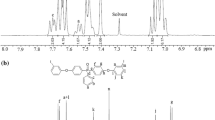Abstract
Dibromofluoracetaldehyde (DBFA) was prepared by reducing methyl dibromofluoroacetate with lithium aluminium hydride (LAH) at low temperatures whereby theLAH was added to dibromofluoroacetate. The initially obtainedDBFA hydrate was dehydrated to the free aldehyde. Methyl dibromofluoroacetate was synthesized together with methyl bromodifluoroacetate by air oxidation of 1,1-dibromo-2,2-difluoroethylene. The mixture of oxidation products, consisting of two acid halides, was treated with methanol and gave a mixture of the methyl esters which here separated by distillation.
DBFA was polymerized with anionic and cationic initiators to crystalline insoluble poly-DBFA. Poly-DBFA degraded quantitatively at elevated temperatures to monomericDBFA. Copolymerization ofDBFA with chloral gave copolymers with nearly the same comonomer composition as the feed.DBFA was also copolymerized with phenyl isocyanate to a copolymer which contained acetal and urethane linkages.
Zusammenfassung
Dibromfluoracetaldehyd (DBFA) wurde aus Dibromfluoressigsäuremethylester durch Addition des Lithiumaluminiumhydrids zum Ester hergestellt. Das zuerst erhalteneDBFA-Hydrat wurde zum freien Aldehyd dehydratisiert. Der Dibromfluoressigsäuremethylester wurde unter gleichzeitiger Herstellung von Bromdifluoressigsäuremethylester durch Luftoxydation von 1,1-Dibrom-2,2-difluorethen erhalten. Das Oxydationsprodukt, das die Säurehalogenide enthielt, wurde mit Methanol behandelt und gab eine Estermischung, die durch Destillation getrennt werden konnte.DBFA wurde mit anionischen und kationischen Initiatoren zu unlöslichen, kristallinen Poly-DFBA polymerisiert. Der polymereDBFA wurde quantitativ bei erhöhter Temperatur zu monomeremDBFA abgebaut. Copolymerisation vonDBFA mit Chloral gab ein Copolymer mit der gleichen Copolymerzusammensetzung wie das ursprüngliche Verhältnis der zwei Monomeren.DBFA copolymerisierte auch mit Phenylisocyanat zu Copolymeren mit Acetal- und Urethangruppen in der Kette.
Similar content being viewed by others
References
S. Temple andR. L. Thornton, J. Polym. Sci.A1, 10, 709 (1972).
O. Vogl, J. Polym. Sci.A2, 4591 (1964).
E. G. Brame, R. S. Sudol, andO. Vogl, J. Polym. Sci.A2, 5337 (1964).
E. G. Brame andO. Vogl, J. Macromol. Sci. (Chem.)A 1 (2) 277 (1967).
O. Vogl Advances in Chemistry Series52, 67 (1966).
B. Yamada, R. W. Campbell, andO. Vogl, J. Polym. Sci., Polym. Chem. Ed.15, 1123 (1977).
R. W. Campbell andO. Vogl, Makromolekulare Chemie, in press.
D. W. Lipp andO. Vogl, in: Ring-Opening Polymerization (T. Saegusa andE. Goethals, eds.). ACS Symposium Series59, 111 (1977).
D. W. Lipp andO. Vogl, Polymer (London)18, 1051 (1977).
P. Kubisa, I. Negulescu, K. Hatada, D. W. Lipp, J. Starr, B. Yamada, andO. Vogl, Pure & Appl. Chem.48, 275 (1976).
P. Kubisa andO. Vogl, Macromol. Synth.6, 49 (1977).
D. W. Lipp, R. W. Campbell, andO. Vogl, Preprints, ACS Polym. Div.18 (1), 40 (1977).
H. Cohn andE. D. Bergmann, Israel J. Chem.2, 355 (1964).
R. W. Campbell andO. Vogl, J. Macromol. Sci (Chem.)A11 (3), 515 (1977).
R. W. Campbell andO. Vogl, Abstr. of Papers, 7th. NERM, No. 312, Albany (1976).
O. Peleta, F. Liska, andA. Posta, Coll. Czech. Chem. Comm.35, 1302 (1970).
R. W. Campbell, Ph.D. Thesis, Univ. of Massachusetts, 1978.
J. Furukawa andT. Saegusa, Polymerization of Aldehydes and Oxides. New York: Wiley-Intersciene. 1963.
A. L. Barney, U.S.-Patent 3,067,173 (1962); CA.59, 10310 B (1962).
W. P. Langsdorf andG. S. Stamatoff, Brit.-Patent 766,629 (1957).
O. Vogl, U.S.-Patent 3,668,184 (1972).
D. W. Lipp, Ph.D. Thesis, Univ. of Massachusetts, 1974.
Author information
Authors and Affiliations
Additional information
Part XII:R. W. Campbell, andO. Vogl, Makromolekulare Chemie, in press.
Rights and permissions
About this article
Cite this article
Campbell, R.W., Vogl, O. Haloaldehyde polymeres XIII. Polydibromofluoroacetaldehyde. Monatshefte für Chemie 110, 453–471 (1979). https://doi.org/10.1007/BF00911933
Received:
Accepted:
Issue Date:
DOI: https://doi.org/10.1007/BF00911933




